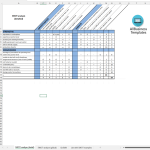Personal Swot Analysis

Enregistrer, Remplir les champs vides, Imprimer, Terminer!
How do I conduct a SWOT analysis and what are some examples? Download this template now which will help you to identify your strengths, weaknesses, opportunities, and threats.
Formats de fichiers gratuits disponibles:
.pdf- Ce document a été certifié par un professionnel
- 100% personnalisable
Business Entreprise HR RH SWOT opportunities Opportunités personal personnel Analysis Une analyse weaknesses faiblesses personal swot analysis analyse swot personnelle Strengths Forces Swot Analysis Example Exemple d'analyse Swot Swot Analysis Examples Exemples d'analyse Swot
Are you looking for a professional personal SWOT analysis? How do I conduct a SWOT analysis and what are some examples? This template will help you to identify your strengths, weaknesses, opportunities, and threats. Download this personal SWOT analysis template now which will help you plan your goals and strategies to succeed in your endeavors.
A personal SWOT analysis is a powerful tool that can help you gain insights into your strengths and weaknesses, as well as opportunities and threats in your personal and professional life. This template is designed to guide you through the process of conducting a comprehensive SWOT analysis, providing you with a structured format to record and analyze your findings.
How to use this template
- Identify Your Objectives: Clearly define your objectives for the analysis. Are you looking to assess your skills, explore career opportunities, or make important life decisions? Having well-defined objectives will help you stay focused during your analysis.
- Identify Your Strengths: Reflect on the characteristics and qualities that you believe contribute to your success. Consider the following categories:
- Skills: List your technical, professional, and soft skills that make you effective in different situations.
- Knowledge: Consider your educational background, expertise, and specialized knowledge.
- Abilities: Identify your natural abilities, such as problem-solving, communication, or leadership.
- Identify Your Weaknesses: Be honest about your limitations and areas for improvement. Consider the following categories:
- Skills: Identify any skills you need to develop or enhance.
- Knowledge: Identify any gaps in your knowledge base that may limit your effectiveness.
- Abilities: Recognize any areas where you could improve, such as time management or problem-solving.
- Identify Opportunities: Consider the external factors and opportunities that may present opportunities for growth, advancement, or success. Consider the following categories:
- Market Trends: Analyze current market trends and anticipate future trends to identify potential areas of growth.
- Career Opportunities: Explore different career paths and consider the opportunities that align with your interests and skills.
- Personal Goals: Reflect on your aspirations and identify opportunities to help you achieve them.
- Identify Threats: Identify the external factors or challenges that may present threats to your personal and professional goals. Consider the following categories:
- Competition: Assess the level of competition in your field and the potential impact it may have on your success.
- Economic Factors: Consider economic factors that may impact your financial stability or employment opportunities.
- Personal Challenges: Reflect on any personal circumstances or health issues that may affect your ability to achieve your goals.
- Analyze and Evaluate: After completing your SWOT analysis, carefully analyze the information you have gathered. Look for patterns and trends that emerge and identify areas of strength and weakness. Evaluate the opportunities and threats you identified and consider their potential impact on your objectives.
- Develop an Action Plan: Based on the analysis, develop an action plan that outlines the steps you need to take to capitalize on your strengths, address your weaknesses, leverage opportunities, and manage threats. Be specific and measurable in your action steps.
- Monitor and Evaluate: Regularly review and update your SWOT analysis to monitor your progress and make adjustments as necessary. This will help you stay proactive and adapt to changing circumstances.
By conducting a Personal SWOT Analysis, you will gain valuable insights into your personal and professional development. This template provides a structured format to capture and analyze your findings, helping you make informed decisions and take appropriate actions toward achieving your goals. Remember, self-awareness is a crucial step in personal growth, and taking the time to conduct a comprehensive SWOT analysis is an investment in your future.
Click directly on 'Open with Google Docs' or download our sample personal SWOT analysis template now to enhance efficiency! Your success in delivering a well-structured and effective SWOT analysis awaits.
AVERTISSEMENT
Rien sur ce site ne doit être considéré comme un avis juridique et aucune relation avocat-client n'est établie.
Si vous avez des questions ou des commentaires, n'hésitez pas à les poster ci-dessous.

